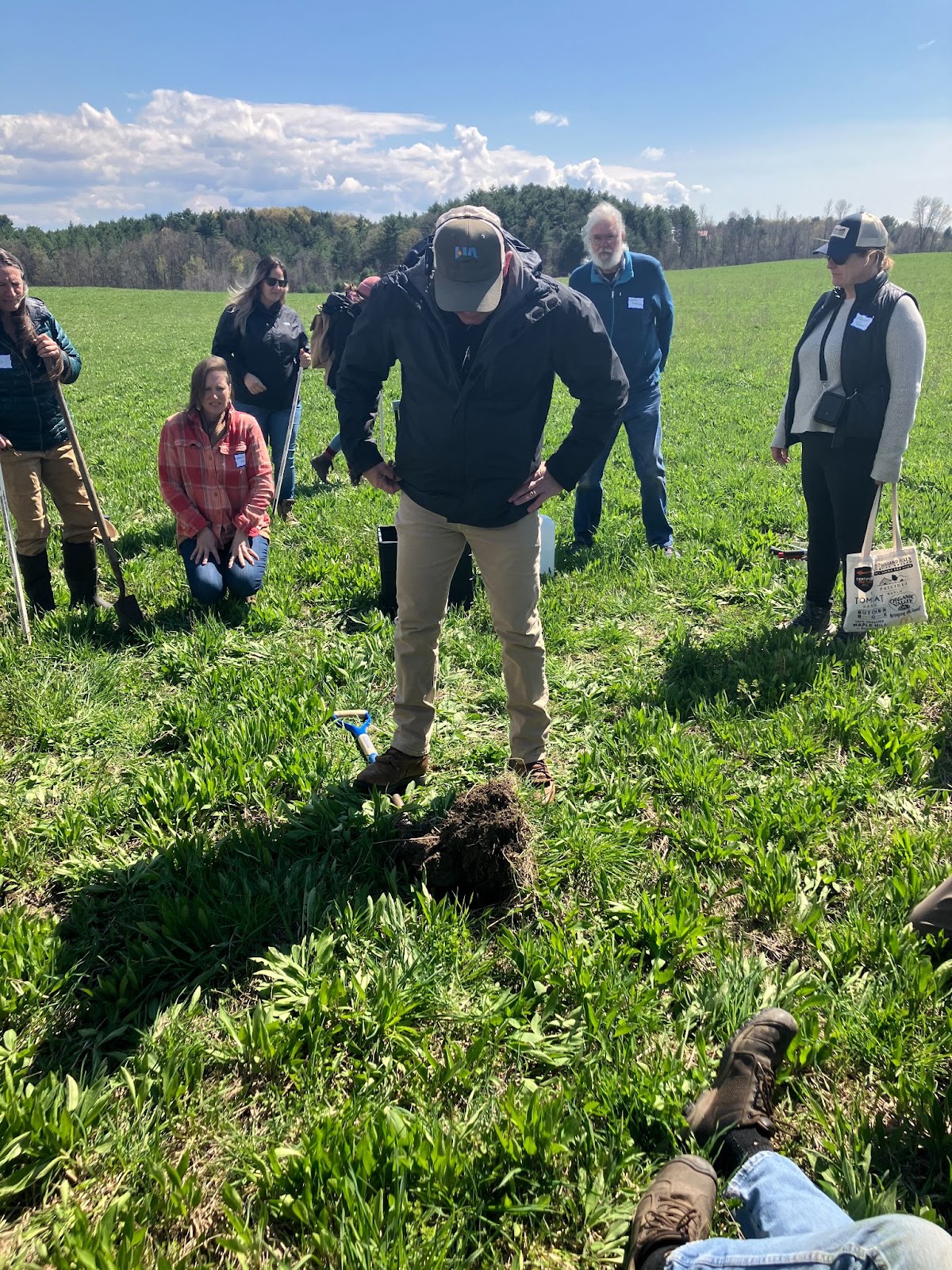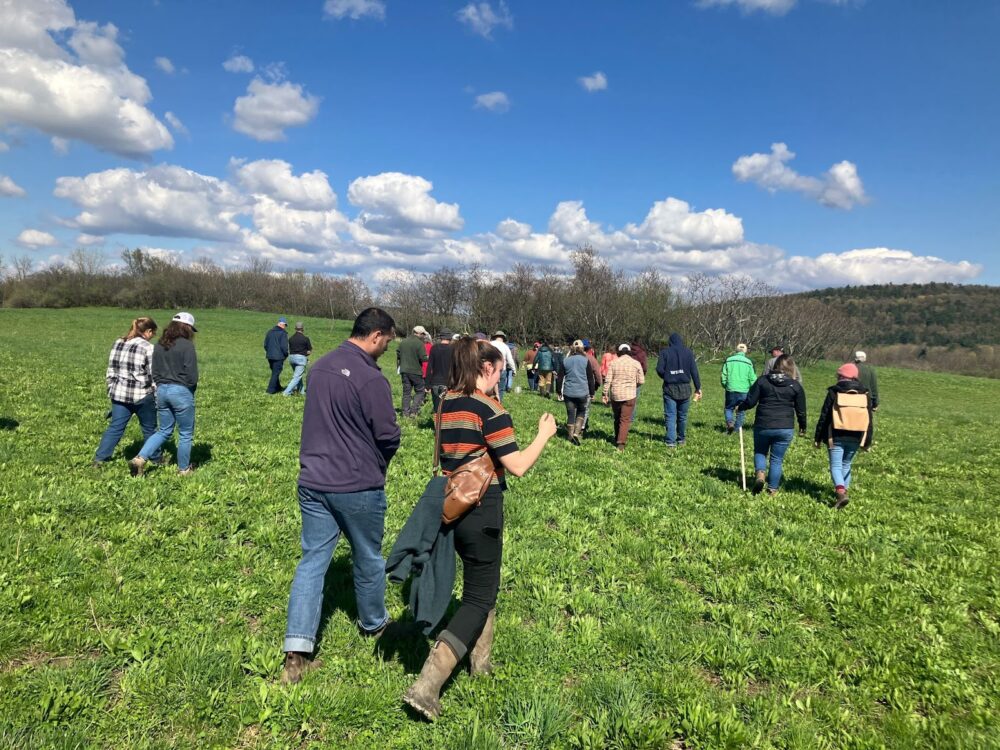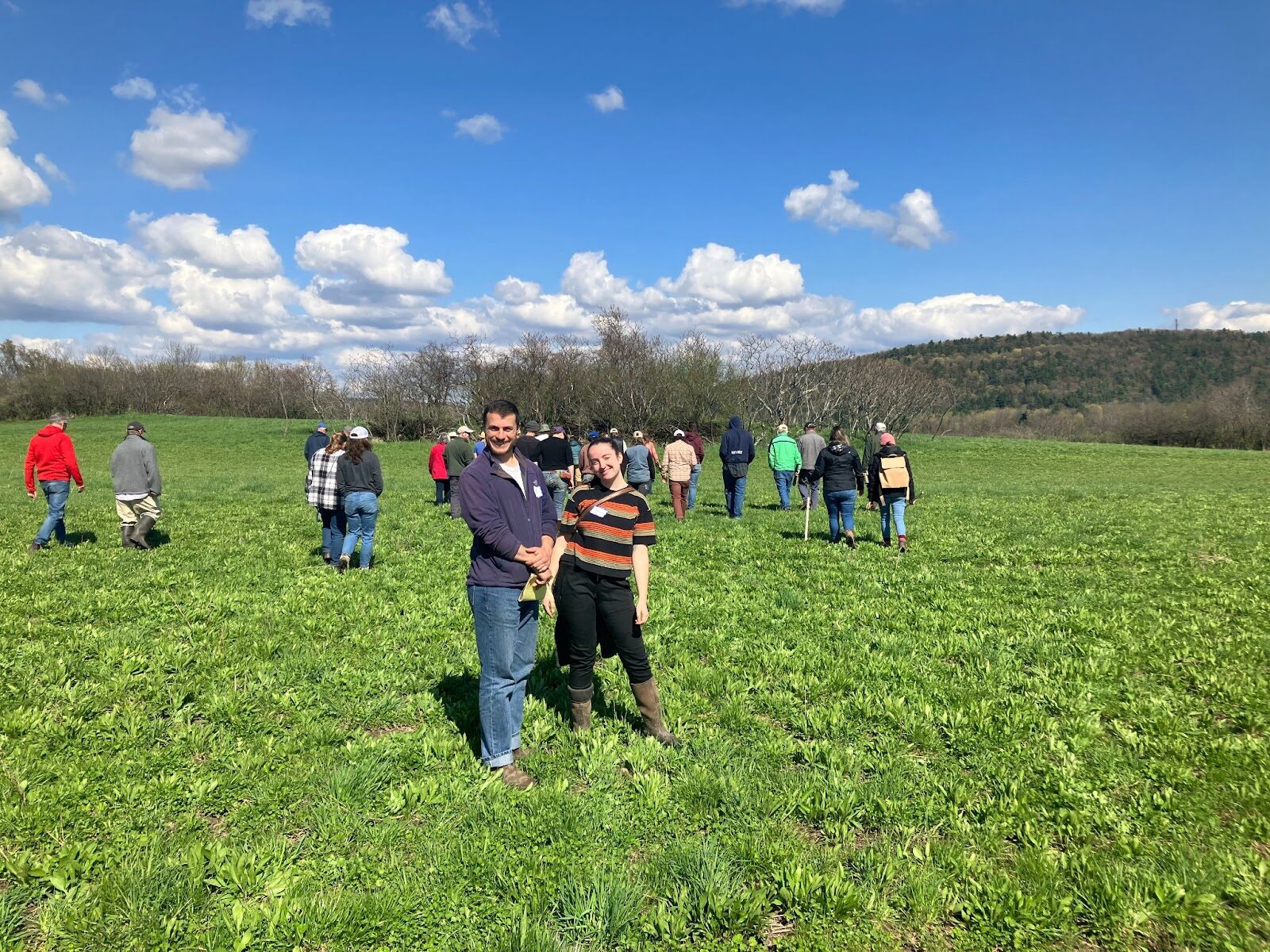Meagan Patch is a regenerative grazier who produces and direct-markets grass-fed beef, pastured pork, chicken and eggs at Patch Farm in Brome, QC. She is part of the Regeneration Canada team as the Project Officer for the Regenerative Dairy Farm Pilot Project in Québec.
I don’t know what it was about this winter, but I’d been lacking the usual sense of joy and anticipation for the upcoming season. Maybe it’s because I made the difficult decision to sell my cows last year and focus on finishing stockers, which means no calves to look forward to this spring. Maybe it’s because the lot of yearlings I got through a buyer last June weren’t the best quality, which meant I had to overwinter most of them. Maybe it was just the lack of sunlight.
Whatever the reason, I had gotten it into my head over the last six months that my grazing wasn’t yielding results on some of my pastures, that I’d hit a wall, and so it was probably time to take extra measures if I wanted to see some improvements in pasture productivity and animal performance this year.
Should I mow the pastures short and drill seed?
Broadcast seed?
Import lime and manure?
Whatever it was, I was going to be spending more money than I could realistically afford. Nevertheless, I reached out to the Pâturages Régénératifs Québec group about seeding into pasture and was offered help from agronomists and farmers alike. But I still wasn’t sure what route I should take.
Allen Williams to the rescue
As luck would have it, on April 27th, Allen Williams would be at Bread and Butter Farm in Shelbourne, Vermont – only an hour and thirty minutes from my farm – and the Regeneration Canada team decided to send me on an assignment. And I really needed to go. I needed to walk the fields, gather with other farmers, listen, ask questions and reflect. It was time for this solar-powered farmer to break out of her funk and seek inspiration (and some much needed vitamin D).
You don’t need to be in the regenerative space for long before you come across Allen Williams. He can be heard speaking on podcasts, in YouTube videos or in documentaries and is a founding partner of Understanding Ag. He is both a scholar and a practitioner of regenerative agriculture and has a gift for explaining the complex relationships between the soil, the plants and the animals in a way that is both accessible and engaging.
On the day of the event, I joined a large group of people who gathered to learn from Allen – and each other – over an afternoon, fueled by some excellent grass-fed beef tacos from our hosts. As much as I’d like to relate every moment of the pasture walk, I will stick to the things that were highlights for me. Some of these concepts aren’t new, but are always reaffirming to hear. Other things I learned, though, actually helped me solve my pasture improvement dilemma.
Troubleshooting grazing challenges
Before getting started, Allen reminded us that context is key and that the moment you get prescriptive about practices, you’re no longer regenerative. He then set an important ground rule for the afternoon’s discussions: we’re not allowed to say, “But we can’t do that here.” This rule forces you to keep an open mind and ask yourself, “What would that look like in my context?”. Allen also reviewed the six principles of regenerative agriculture, the three rules of adaptive stewardship, and the four ecosystem processes (AKA 6-3-4).
The field we were looking at had recently been taken over by Bread and Butter Farm and until then, it had been managed conventionally, meaning that more had been taken than given back for many years.
We started with a soil profile analysis. If you’re not familiar, it works like this:

1. Stick the shovel end in the ground and jump on it. If the shovel doesn’t sink in very much, your soil has some compaction.
2. Pull the shovel backwards and down to pop up a clump of soil. If the shovel breaks, your soil is definitely compacted. (Or it’s just time for a new shovel.)
3. Profile analysis:
a. What does the top look like? Crusty or crumbly? If it’s crusty, you likely have some capping and therefore water infiltration issues.
b. Aggregates’ size and depth: Large aggregates are a good sign.The deeper they go, the better.
c. Colour: Does it change with depth? Darker = more carbon. We want the dark layer to go deep.
d. Plates: A platy soil forms clearly defined horizontal layers. Is there a plate where the roots stop? How far down is it? Good root action will break this up.
e. Bulk density: Is the soil heavy or light? Highly aggregated soil will be lighter.
f. Aroma test to confirm microbial activity: The soil should have a nice smell. A metallic smell is a sign of highly bacterial soil (high bacteria to fungal ratio).
The soil had a crumbly crust, a 3” layer of it darker with small aggregates and a clear split just below where the plating begins. This pasture was on the healing path.
Brandon Bless, who is in charge of animals and land at Bread and Butter Farm, listed the different interventions they had tried on difficult sections of land and challenged us to a quiz: Which of the following effectively accelerated improvements on problematic pastures?
a. Keyline ploughing
b. No-till drill seeding
c. Broadcast seeding
d. Mowing
e. Bale grazing
If you guessed bale grazing, then you are correct, my friend. Nothing seems to compete with good ole bale grazing, which effectively delivers a combination of disruption, fertility, soil armor, and a larger seed bank, to name a few.
Topics that ensued included forage species and improving pasture quality. This is when I realized that I had forgotten to try a few more things on my difficult sections before resorting to machines. After spending a lot of time recently worrying about how I may not have enough legumes in my pastures, Allen told us that:
● Many people have too many legumes in their pastures. In nature, legumes make up 10-12% of grassland species.
● Too many legumes can cause an imbalance in the carbon to nitrogen ratio, which causes microbes to over consume soil carbon. I was aware of this dynamic where mineral fertilizers are concerned, but it never occurred to me that this could happen with nitrogen-fixing plants.
● Too many legumes can also result in too much protein in the diet. This can create a microbial imbalance in the rumen as well and cause health issues like pinkeye.
● Native grasslands can contain up to 30-40% forbs species. I never hear much talk about forbs, so this was definitely interesting and has set me on a quest to learn more about them.
● Native prairies contain around 250 or more species – a reminder for me that it makes more sense to work on finding beef genetics that will thrive in a diverse plant ecosystem rather than to battle with establishing a higher-than-normal density of legumes.
When asked about how to maintain populations of forbs within an intensive grazing management system, Allen cited the importance of adequate rest periods before returning to a paddock. Short rest periods narrow the species diversity. A strategy for ensuring adequate rest is to afford longer than usual rest periods on different sections on alternating years. This was another lightbulb moment for me, as I realized that I had not quite mastered the adaptive stewardship rule of disruption in my management, and I started to think of the disruptive techniques that I had not yet experimented with, like hitting certain difficult spots with higher stock density or allowing longer periods of rest on alternating years. Both have been a challenge for me because of trouble keeping enough power on certain fencelines or logistical issues; but I am determined to find solutions this year.

To mow or not to mow?
This is a question folks who are newer to regenerative land management often ask themselves, especially when they see “weeds” cropping up. But it can also come up when deciding whether or not to include hay fields in a grazing plan. In conventional farming, grazing lands and hay fields are often managed very differently, with little overlap in use. Of course, sometimes the reasons are obvious, such as when pasture land is too rough to cultivate for hay, or when hay fields are too far to use as pasture or involve infrastructure investments that don’t make economic sense.
However, in cases where there are few logistical constraints, a very strong argument could be made for including hay land in a managed grazing program. This is something I have personally observed at my farm after years of only grazing all of our fields and buying in our hay. Our fields are often more advanced at hay time compared to fields in the area that have been regularly limed, seeded and fed mineral fertilizers.
But Brandon’s example is the best, because Bread and Butter Farm ran an experiment last year and measured the results: They split a section of land in halves, and took 2 cuts of hay off one half. The other half of the field was grazed during the first cut period of the season, and mowed at the second cut stage. There was 120% more biomass harvested from the previously grazed half of the field compared with the half that had only been mowed.
What could be causing this huge difference in yield? To paraphrase Allen, biology builds biology. Mowing does not mimic grazing. Grazing sends a different signal to the plant than mowing does, causing the plants to respond differently. Also, during grazing, saliva, urine and manure that match the microbiome of the soil are left behind by the cattle or sheep. With proper grazing management, you should never have to reseed a pasture.
Onwards!
Every time I attend a pasture walk, I come away with something new to try or a shift in perspective. The afternoon I spent with Allen Williams and the many other passionate farmers got me thinking about how I still had some things left in my grazing management toolbox to try.
My three main takeaways from the day are 1) to make sure I am incorporating disruption into my management, 2) remembering that biology builds biology, which means that machines can’t replace animals if your objective is to build soil, and 3) the power of collective intelligence.
The next time I’m struggling with low motivation or I hit a wall with my grazing management, I will sign myself up for a pasture walk.




